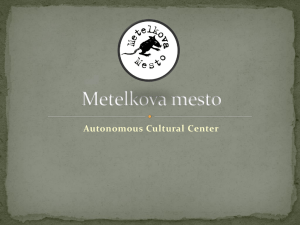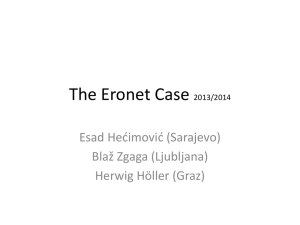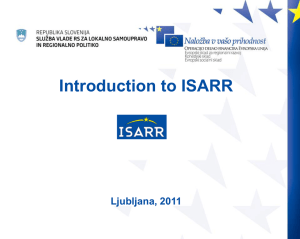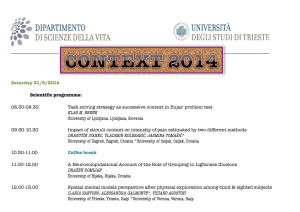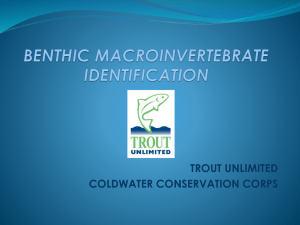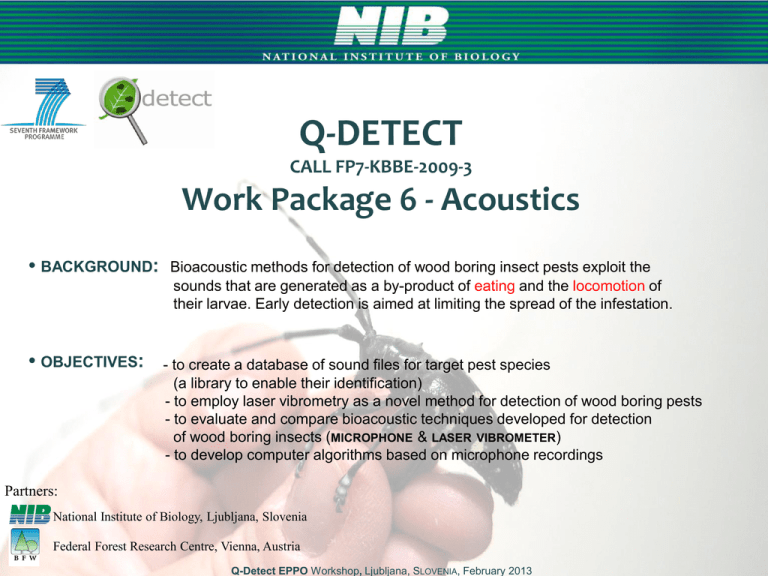
Q-DETECT
CALL FP7-KBBE-2009-3
Work Package 6 - Acoustics
• BACKGROUND:
• OBJECTIVES:
Bioacoustic methods for detection of wood boring insect pests exploit the
sounds that are generated as a by-product of eating and the locomotion of
their larvae. Early detection is aimed at limiting the spread of the infestation.
- to create a database of sound files for target pest species
(a library to enable their identification)
- to employ laser vibrometry as a novel method for detection of wood boring pests
- to evaluate and compare bioacoustic techniques developed for detection
of wood boring insects (MICROPHONE & LASER VIBROMETER)
- to develop computer algorithms based on microphone recordings
Partners:
National Institute of Biology, Ljubljana, Slovenia
Federal Forest Research Centre, Vienna, Austria
Q-Detect EPPO Workshop, Ljubljana, SLOVENIA, February 2013
Pine Sawyer
• TARGET SPECIES:
(Monochamus galloprovincialis,
Monochamus sp.)
Red Palm Weevil
ASian Longhorn Beetle
(RPW, Rhynchophorus ferrugineous)
(ALB, Anoplophora glabripennis)
• HOSTS:
1. deciduous trees
(Acer, Populus, Ulmus …),
2. cut wood
3. wood packaging material
(PORTS – points of entry!)
host: Pinus
sylvestris, P. nigra,
P. pinaster …
vector of pine
wilt disease!
Two preferred host palms:
- Canary Island Date
Palm (Phoenix canariensis)
- (true) Date Palm
(P. dactylifera)
• MEASURING
INSTRUMENTS:
portable digital laser vibrometer
(PDV-100, Polytec, Waldbronn, Germany)
Q-Detect EPPO Workshop, Ljubljana, SLOVENIA, February 2013
microphone
Anoplophora glabripennis (Cerambycidae)
The ASIAN LONGHORN BEETLE attacks mainly healthy trees.
Hosts include broadleaf tree species, mostly maple, but also
beech, horsechestnut, poplar, birch, willow etc.
adult
Females tend to live longer than males, 14-66 days compared to 3-50
days respectively. ALB may have one or two generations per year.
They can overwinter as an egg, larva or pupa. ALB fly for 2 to 3 days
after emergence while mating and feeding. Adult ALB are usually
present from May to October.
A single female can lay 30 to 70 eggs in her lifetime. After 10-15 days,
the eggs hatch and the larvae tunnel into the wood. The adults burrow
out of the tree, leaving round exit holes 6-18 mm in diameter.
larva
damage caused by larvae
exit holes of adults
damage caused by feeding adults
Q-Detect EPPO Workshop, Ljubljana, SLOVENIA, February 2013
www.invasive.org/gist/photos/
The pine sawyer Monochamus galloprovincialis (Coleoptera: Cerambycidae)
adult
Monochamus beetle attacks mainly weakened trees, but when
abundant it can also attack healthy trees weakened by the
complementary feeding of adults and incisions made by females.
Heavy larval feeding causes the death of trees and lowers the timber
value.
Monochamus galloprovincialis is the vector of the pathogenic
nematode Bursaphelenchus xylophilus.
Insects require 10 to 13 months to develop and have a single generation per
year. The emergence occurs from May to September with a peak in July.
Females lay eggs from May to August and the young larvae have an extremely
fast development before tunneling into the xylem, where they overwinter.
larva
vector for a pine wilt nematode,
Bursaphelenchus xylophilus
which causes pine wilt disease:
damage caused by larvae
Q-Detect EPPO Workshop, Ljubljana, SLOVENIA, February 2013
Rhynchophorus ferrugineus (Coleoptera: Curculionidae)
THE RED PALM WEEVIL
Preferred hosts:
canary date palm
date palm and coconut palm.
adult
larva
cocoon
Several generations of larvae
may be present in one palm tree;
the RPW will not leave the palm
as long as there is still enough
food for the developing
larvae. While the adults cause
some damage through feeding,
it is the burrowing of the larva into
the heart of the palm that can cause
the greatest mortality. Several life cycles may
be completed in one year, depending on the climate.
the base of leaf attacked by the RPW
life cycle
palm tree dying off due to RPW infestation
Q-Detect EPPO Workshop, Ljubljana, SLOVENIA, February 2013
OTHER POSSIBLE SOURCES OF LARVAL SOUNDS – BREATHING,
SCRAPING MANDIBLES AGAINST THE BARK, STRIDULATION?
SOUND PRODUCTION IN LARVAE OF CERAMBYCIDAE is
a rare phenomenon described in only few species.
Larvae probably emit the sounds by the scratching of
mandibles against the gallery walls (or knocking of the
head against the wall of larval burrow) (Kočárek, 2009;
Victorsson and Wikars, 1996; Izumi et al., 1990).
WHY DO WE DO IT?
- sounds directed to the larvae of the
same species for the purpose of holding
together or expressing claim of space;
- helps the larva secure resources by
keeping away other potentially competitive
larvae (canibalistic behaviour among larvae
of M. sutor when placed in close contact
confirmed this assumtion).
Wessel (2006): Stridulation in the Coleoptera – An Overview
(In: Insect Sounds and Communication;
Drosopoulous, Claridge (eds.); CRC Press)
No mention of larval stridulation in either
Curculionidae or Cerambycidae family found
in the literature.
Q-Detect EPPO Workshop, Ljubljana, SLOVENIA, February 2013
ALB
• Recordings were made from wood that was
cut as a part of an eradication programme
in the Veneto region of N Italy and kept in
the quarantine room at the Federal Forest
Research Centre in Vienna (BFW).
Anoplophora glabripennis
A clip of an ALB
recording from
a Populus sp. log.
2 ms
ALB bites
22
kHz
0
kHz
Q-Detect EPPO Workshop, Ljubljana, SLOVENIA, February 2013
short duration:
1.5-2 ms;
max intensity at
8-10 kHz.
Several pulses are
sometimes merged
into a longer signal.
RPW
Rhynchophorus ferrugineous
• in Slovenia there was only one case of RPW infestation so far (2009);
• recordings of RPW activity were thus carried out abroad;
two most successful field trips took place in June 2011 (Italy)
and March 2012 (Israel).
• Bari, Italy, June 2011:
In cooperation with IAMB (Mediterranean Agronomic Institute of Bari)
and University of Bari recordings were carried out on several infested
Phoenix canariensis trees in urban Bari;
Additionally, eight P. canariensis leaves were collected and one RPW larva
was inserted inside each rachis (petiole); vibrations were recorded with the
laser vibrometer from the surface of leaves.
Q-Detect EPPO Workshop, Ljubljana, SLOVENIA, February 2013
RPW
Rhynchophorus ferrugineous
• Beit Dagan, Israel, March 2012:
In cooperation with the 7th FP Palm Protect
(Dr. Victoria Soroker), recordings were made on
potted Date and Canary Palms at the Volcani Center
of the Agricultural Research Organisation (ARO).
Q-Detect EPPO Workshop, Ljubljana, SLOVENIA, February 2013
slide courtesy of:
Dr. Victoria Soroker,
Dr. Amots Hetzroni, ARO, Israel
SENSITIVITY
SPECIFICITY
LASER VIBROMETER
MICROPHONE
0.88 (0.75-1)
0.84 (0.70-0.95)
0.88 (0.75-1)
0.66 (0.50-0.70)
Q-Detect EPPO Workshop, Ljubljana, SLOVENIA, February 2013
RPW sounds
short: ‘clicks’
AND
duration:
1-4 ms
main signal energy lies between:
3-8 kHz
"CLICK"
long: ‘rasps’
duration:
ca. 450 ms
main signal energy lies between:
2-3 kHz
"RASP"
Q-Detect EPPO Workshop, Ljubljana, SLOVENIA, February 2013
ADVANTAGES/ DISADVANTAGES OF THE LASER VIBROMETER COMPARED TO THE MICROPHONE
• Microphones, for example, lack a complete coupling
with the substrate and therefore detect also the
airborne component of he emitted structure-borne
signals. They demand amplification → the signals that
are picked up are inevitably masked by the
environmental airborne noise.
• The laser vibrometer, however, records only
substrate-borne vibrations.
• Contrary to accelerometers, microphones or
other bioacoustic sensors, laser vibrometers
are completely non-contact and as such are
not affected by the properties of the test
surface. Zero loading of the test surface
also means that the mechanical properties of
the measurement surface are not modified in
any way during the recording.
• LV is characterized by high sensitivity and
a broad frequency range between 0 and 22 kHz,
PDV-100
• robustness and
• a working distance of several meters to
the tested surface, which expands recording
posibilities in relation to previously used
acoustic methods for detection of wood boring
insects.
disadvantage:
laser vibrometers are expensive but with their wide
use in measurements where conventional sensors
may be difficult or impossible, their price is
decreasing and they will become more and more
accessible for use in science and applications.
IDEAL FOR USE IN THE FIELD:
- lightweight (2.6 kg) portable
laser vibrometers,
- very robust
- 4h battery time
Q-Detect EPPO Workshop, Ljubljana, SLOVENIA, February 2013
OVERVIEW
PEST
ALB
Total
duration of
recordings
with larval
activity
3 h 40 min
4 h 30 min
RPW
TOTAL
2 h 30 min
ca. 11 hours of
audio data
(.wav)
Number of wood
samples/trees/leaves
with
recorded signals
Populus, Acer
(2r = 10-20 cm,
l= 40-90 cm)
4x
Phoenix canariensis
P. dactylifera
21x
(2r = 10-20 cm,
h = 1.5-3 m)
leaves larvae inserted 4x
into the base
29 plant samples
Longest
time
between
two signals
*
6 min
2.5 min
1 min
- large databases of laser recorded
sound files for ALB (Anoplophora
glabripennis) and RPW
(Rhynchophorus ferrugineus) are
established
- information on the uncertainties,
quality (sensitivity/specificity) and
full protocols for RPW and ALB
detection were provided to WP2
- collaboration with Palm Protect
project is well established through
Dr. Victoria Soroker of ARO, Israel.
max 6 minutes
*Maximum recording time required to detect if the pest is active.
Q-Detect EPPO Workshop, Ljubljana, SLOVENIA, February 2013
FUTURE
WORK
1. Dissemination events/Workshops:
Brussels, January 2013 (DG SANCO)
Ljubljana, February 2013 (EPPO Workshop)
2. Publication of work in
EPPO Journal;
SCI Journals (J Econ Entom, …),
3. Create a task force (with Analogue Electronic Depts. at faculties or SMEs that specialize
in anal. elec.) and search for suitable funding schemes to fund the continuation of the project.
Q-Detect EPPO Workshop, Ljubljana, SLOVENIA, February 2013
Acknowledgements
ITALY
Servizio Fitosanitario Regione del Veneto
Univesità di Padova
Servizio Forestale di Treviso
Istituto Agronomico Mediterraneo di Bari
Univesità di Bari
Dr. Marco Vettorazzo
Stefano Palmieri
Dr. Andrea Battisti
Dr. Massimo Faccoli
Michele Coppe
Dr. Anna Maria D’Onghia
Francesco Porcelli
ISRAEL
Agricultural Research Organization,The Volcani Center
Dr. Victoria Soroker
Dr. Amos Mizrach
Dr. Amots Hetzroni
GERMANY
Sejona R&D
Dr. Sebastian Hübner
AUSTRIA
BFW
Ing. Martin Brandstetter
Dr. Christian Tomiczek
Philip Menschorn
SLOVENIA
NIB, Dept. of Entomology
Prof. Dr. Andrej Čokl
Dr. Maja Zorović
Jernej Polajnar
Q-Detect EPPO Workshop, Ljubljana, SLOVENIA, February 2013
THANK YOU
FOR YOUR
ATTENTION!
Laser vibrometer
N=21
Observer + *
Observer - **
Larva found
15 (17)
2 (1)
No larvae
0 (2)
2 (3)
Microphone
N=28
Observer + *
Observer - **
Larva found
21 (9)
4 (1)
No larvae
1 (3)
2 (5)
* observer decides the tree IS infested
** observer decides the tree IS NOT infested
slide courtesy of:
Dr. Victoria Soroker,
Dr. Amots Hetzroni, ARO, Israel
Q-Detect EPPO Workshop, Ljubljana, SLOVENIA, February 2013
Lucanus cervus (stag beetle)
LARVAL STRIDULATION
The stridulatory apparatus of stag beetle larvae
consists of a pars stridens (file) on the coxae on
the middle legs and a plectrum (scraper) on the
trochanter of the hind legs. The larvae rub these
parts, in their middle and hind legs, together to
produce a sound. The sound is a very short rattle,
repeated once or twice. It lasts ca. 1 second and
the sound frequency is about 11 kHz.
http://maria.fremlin.de/stagbeetles/stridulation.html
Sebastian Hübner: BFW study
stridulation
larva RPW
1. DO LARVAE STRIDULATE?
2. DO PUPAE STRIDULATE?
overview Wessel (2006): Stridulation
in the Coleoptera – An Overview
(In: Insect Sounds and Communication;
Drosopoulous, Claridge (eds.))
Monochamus sutor larva
Sequenz mit 47
breitbandigen
Stridulationslauten in
Folge. Die Länge der
Sequenz beträgt fast
vier Minuten.
Stridulation in larvae maxillo-mandibular
Cetoniidae, Dynastidae,
Melolonthiade, Ruteliade
mesocoxa-hind leg
Passalidae, Geotrupidae
metatrochanto-mesocoxal
Stridulation in pupae
Drei breitbandige
Stridulationslaute
in Folge
gin-traps of tergites 1 to 6
Lucanidae
Dynastidae
No mention of larval stridulation in either
Curculionidae or Cerambycidae family
found in literature.
PEST
ALB
Total
duration of
recordings
with larval
activity
3 h 40 min
4 h 30 min
RPW
2 h 30 min
TOTAL/
max
ca. 11 hours of
audio data
(.wav)
Number of wood
samples/trees/leaves with
recorded signals
Populus, Acer
(2r = 10-20 cm,
l= 40-90 cm)
4x
Phoenix canariensis
P. dactylifera
21x
(2r = 10-20 cm,
h = 1.5-3 m)
leaves larvae inserted 4x
into the base
29 plant samples
*Maximum recording time required to detect if the pest is active.
Longest time
between two
signals *
6 min
2.5 min
1 min
max 6 minutes
- large databases of laser recorded
sound files for ALB (Anoplophora
glabripennis) and RPW
(Rhynchophorus ferrugineus)
- collaboration with
Palm Protect project

